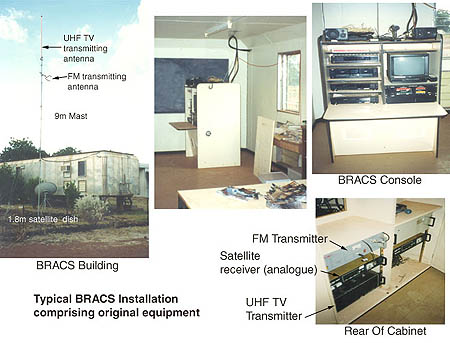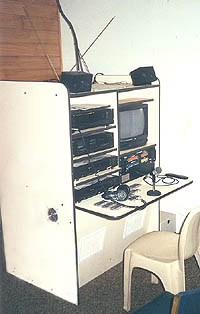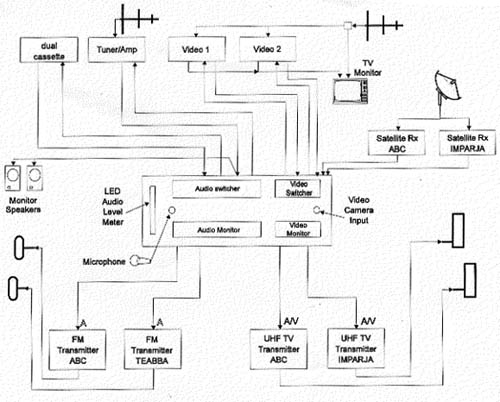|
BRACS
is a network of community broadcast stations. Each BRACS
unit costs between $30 000 and $40 000.
Twenty-two
of the designated BRACS installations located in the
Top End of the Northern
Territory are under the following regional councils:
| Jabiru |
Nhulunbuy |
Katherine |
| Nguiu |
Ramingining |
Bulman |
| Pularumpi |
Milingimbi |
Beswick |
| Milikapiti |
Gapuwiyak |
Barunga |
| Minjilang |
Galiwinku |
Ngukurr |
| Warrawi |
Yirrkala |
Daguragu |
| Oenpelli |
Umbakumba |
Numbulwar |
| Maningrida |
Angurugu |
Lajamanu |
| Peppiminarti |
|
|
| Pulumpa |
|
|
| Wadeye |
|
|
Prior
to the launch of the Aussat satellite in 1985, there
were no mainstream television or radio re-transmission
services available in Aboriginal or Torres Strait Island
communities.
With
the coming of the satellite launch in 1985, it heightened
concerns by the community of the impact mainstream television
and radio services would have on their culture.
In
response to these concerns, the Government at the time,
set up a task force chaired by Eric Wilmot, head of
Department of Aboriginal Affairs (DAA), to investigate
the media needs of the Aboriginal and Torres Strait
Island people.
From
his investigations came the report, Out of Silent
Lands, published in 1984. The report recommended
that basic satellite receiving and re-transmission equipment
be installed into 80 Aboriginal and Torres Strait Island
communities throughout Australia, the project came to
be referred to as Broadcasting for Remote Aboriginal
Communities Scheme (BRACS).
What
was achieved
Initially the recommendations from the DAA report, were
to spend approximately $250 000 per site on both radio
and video equipment, this was later reduced to approximately
$30 000 per site. For this, each community would receive
a basic broadcast facility fitted out with domestic
and semi professional equipment.
Each
station would have the capacity to broadcast two FM
radio services, the ABC and the Central Australian Aboriginal
Media Association (CAAMA)
service. Two UHF television services were also provided,
broadcasting programs from ABC and IMPARJA, the Central
Australian Aboriginal television service, part of CAAMA.
To
address the concerns by the community of the impact
mainstream television and radio services would have
on their culture, switching facilities were provided
that gave the ability to control undesirable material
from being broadcast - the offending program, radio
or video, could be switched off and local program inserted.
Equipment
used
The original BRACS design comprised a wooden cabinet
that housed all the radio and video replay and transmission
equipment that included satellite receivers, UHF transmitter
and FM transmitters. Located outside in close proximity
to the BRACS room was a satellite dish and a nine metre
guyed, pipe mast.

Photo: Evan Wyatt. Courtesy: TEABBA
|
The
transmission side generally consisted of two 20 watt,
rack mounted FM transmitters, giving a range of approximately
15km and 2 watt UHF rack mounted television transmitters,
this equipment was located in the rear of the consoles.
|
Each
unit was fitted with a switching panel to select
the desired radio or video program for broadcast,
the radio side consisted of a dual cassette deck,
tuner and stereo amplifier with monitor speakers,
and a microphone mounted on a desk stand for local
broadcasting.
The
video equipment installed was of domestic quality
and included:
- 2
VHS video recorder/players
- a
television set that doubled as a monitor
- a
portable video camera for local production work.
The camera could be connected to the switching
panel, allowing live to air broadcasting.
Telecom
(now Telstra), were contracted to manage the project
and purchase and install the equipment. The first
trial unit was installed at Jigalong, in the Pilbara.
The last unit was installed in late 1991, with
80 units installed Australia wide. The final cost
for this project was close to $3m.
|

Components of the original
BRACS set-up. Photo: Evan Wyatt. Courtesy:
TEABBA |
|
BRACS
sites were set up in the following areas:
- Pilbara
and Kimberley region of Western Australia
- northern
area of South Australia
- throughout
the Northern Territory
- north
Queensland
- Torres
Strait Islands.

Equipment interconnections. Courtesy:
TEABBA |
Click
here for more detail on how the BRACS network developed.
|